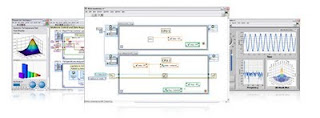
National Instruments has launched its the latest version of the LabView graphical system design software platform for test, control and embedded system development. LabVIEW 2009 simplifies the development challenges of complex test systems with new tools that streamline the software engineering process for the development, deployment and maintenance of critical test software. It uses parallel programming features such as virtualisation technology that increase the performance for multicore-enabled test applications and offers LabVIEW FPGA compiler improvements to simplify field-programmable gate array (FPGA) reconfigurable I/O (RIO) development. In addition, LabVIEW provides new solutions for testing systems based on wireless standards such as WLAN, WiMAX, GPS and MIMO using a common hardware platform.
“In today’s challenging economic climate, engineers and scientists are being asked to complete their projects with fewer resources and in less time,” said Dr. James Truchard, President, CEO and Cofounder of National Instruments. “With LabVIEW 2009, test engineers can develop complex and mission-critical applications faster while improving their overall test system performance.”
Streamline Test Software Validation
LabVIEW 2009 features new tools for software engineering and code validation that make it possible for engineers and scientists to easily meet the regulatory and software engineering requirements of complex test systems. With the new version of LabVIEW, engineers and scientists can trace the implementation of test system requirements to virtual instrument (VI) programs and easily monitor low-level details about the execution of critical VIs for quick application monitoring and debugging. In addition, LabVIEW 2009 can automate the functional testing of each VI to guarantee that the VIs meet all necessary specifications. These new software engineering tools complement existing LabVIEW features for large application development and help engineers and scientists create high-quality test systems.
Improve Parallel System Development
With LabVIEW 2009, engineers and scientists can easily develop applications that take advantage of inherently parallel technologies such as FPGAs and multicore processors. Virtualisation technology makes it possible to run multiple OSs side by side on the same multicore processing hardware to build more efficient systems. Using new NI Real-Time Hypervisor software, engineers and scientists can run Windows XP and LabVIEW Real-Time OSs side by side on the same PXI embedded controller and partition the processor cores among the two OSs for more efficient use of system resources.
The LabVIEW 2009 FPGA Module also further reduces the time required to program FPGA RIO devices by providing early compile feedback and critical path highlighting during compilation and simulation on a development computer. This helps engineers and scientists make early FPGA resource usage estimates and better debug timing violations. They also can further reduce development time by simulating the behavior of an FPGA on a development computer instead of compiling to the FPGA.
Test More Wireless Devices and Standards
LabVIEW 2009 improves the performance of radio frequency (RF) and wireless test by taking advantage of multicore processors. For example, engineers and scientists can use LabVIEW and off-the-shelf multicore processors to increase the speed of wireless measurements such as spectral masks and error vector magnitude used in WLAN test. The recently released NI WLAN Measurement Suite for LabVIEW guarantees compliance with IEEE 802.11 a/b/g standards and performs measurements more than five times faster than traditional box instruments. With software-defined instrumentation using LabVIEW, engineers and scientists can implement the same measurement platform to generate, analyse and simulate nearly any wireless standard or custom protocol. In addition to the WLAN Measurement Suite, the recently released WiMAX, GPS and MIMO tools for LabVIEW help engineers and scientists increase their performance when testing multiple standards using a common PXI hardware platform.

![Reblog this post [with Zemanta]](http://img.zemanta.com/reblog_e.png?x-id=550d2e6c-eca4-41c4-9802-9b42045b9b20)
No comments:
Post a Comment